
Sundararaman Ramanan, a globally recognised Differential Geometer, spent nearly five decades pursuing mathematics in TIFR Mumbai, first as a PhD student, and later on as a valued member of its formidable faculty. His mathematical career and work overlapped with the careers of many other highly distinguished mathematicians of that era, contributing to the establishment of TIFR as a preeminent centre of excellence in many areas of mathematical research. Equally at ease with both research and pedagogy, Ramanan boasts of a sizeable and an enviable bevy of students, many of whom have gone on to blaze their own individual trails in mathematics. Here he reminisces on his life, career, and avocations.
It is indeed a pleasure to welcome and engage you in a conversation with Bhāvanā. Thank you very much. We hear that you have a very scholarly paternal family background, with many of them involved in priestly duties. Can you please tell us a bit about your place of birth, and also on your overall paternal family history?
SR: Many of my paternal ancestors were Vedic scholars, and a few of them even ran Veda pāṭhaśālās, or Vedic schools, as well. A few among them were also priests. My father’s elder brother, Ramachandra Dikshithar, and their maternal uncle, Venkatesa Dikshithar, were proficient in the Vedas, Upanishads and their commentaries by eminent individuals. Both of them were Sanskrit professors, and received the President’s award for their erudition in Sanskrit. Many of my direct ancestors were also landowners; the land was perhaps donated to them by zamindars, and their sustenance came mainly from agricultural produce. But over generations, thanks to repeated partitions, the share dwindled, and by my father’s generation, they had to seek other avenues of sustenance.
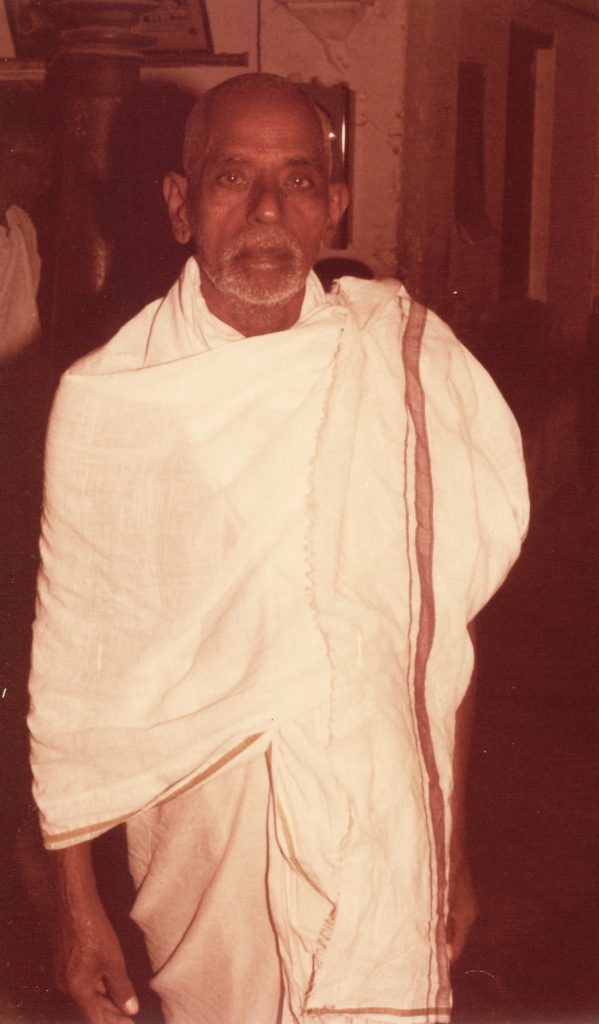
What about your maternal background? Were there accomplished Sanskrit scholars on your mother’s side as well?
SR: My maternal grandfather was a well-known lawyer in Vellore, but had a big family to support. My mother had five sisters and two brothers. Moreover, her father passed away rather early, and the family had become somewhat needy.
In particular, what role did your own parents play individually, in your upbringing?
SR: My father was the first in the family to seek employment in a profession other than the traditional ones. He became a stenographer in a British firm in Bombay (now Mumbai). Because of his upbringing, he had studied some Sanskrit. My brother, my only sibling, and I received some traditional education, such as learning to chant the Puruṣa Sūktam etc., and also gained some knowledge of literary works such as Kalidasa’s plays. Of course, as in most Brahmin families in those days, our parents emphasised good performance at school. My mother, who did not have an education beyond middle school, had however learnt English and regularly read newspapers and magazines, both in English and in Tamil. She would also read Tamil novels. Perhaps this inculcated in me the habit of reading.
That’s indeed very interesting. So, you had strong connections to two major cities of pre-Independence India, Madras and Bombay, as they were then called. As a young boy growing up in Bombay in the early 1940s, where were you enrolled for school education?
SR: I was born in Madras on 20th July 1937 and spent my first eight years in Bombay. We lived in Matunga, populated predominantly by people from South India.
You have a very strong interest in Indian classical music, especially of the Carnatic kind. Where and when exactly were you first initiated into music? Does it run in your family?
SR: My mother had learnt Carnatic music in her childhood. My father encouraged her to continue learning after marriage. Her teacher in Bombay was Krishna Bhagavathar, whose son, Bombay Balaji, later became a well-known Mridangam artiste in Chennai. My parents and I regularly listened to radio broadcasts of some great musicians, particularly the National Programme of Music on Saturday nights. So there was a lively musical atmosphere at home. Later, I also started going frequently to live concerts of all the well-known musicians of that time. But I started learning music formally only much later.
And then all of a sudden, your family left Bombay to go back to Madras. How did this come about?
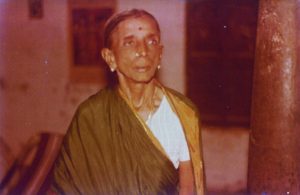
SR: My father was miffed at being superseded at work by an Anglo-Indian, rather unfairly, he felt. He chose to resign and start a business. After a couple of infructuous attempts at buying a printing press in Bombay, he decided to return to Madras and try his luck there. This was a difficult choice, since he was one of the founders of the South Indian Bhajana Samaaj in Matunga, and had become a prominent member of the community there. He officiated as the secretary of the organization for nearly twenty years. The decision to leave it all and enter a new field in a new environment must have been hard.
Back in Madras, you joined the venerable Ramakrishna Mission School, an institution that, we hear, has deeply influenced you. Your thoughts on this period of your life, and also on the culture of learning prevalent in the Ramakrishna Mission schools. ?
SR: Yes. I have very nice memories of my school days there. Many teachers were dedicated to the profession, which was to them more than just a medium of livelihood. India became independent around the time I reached high school. So there was a lot of flux in the educational field as well. The medium of instruction, which was till then English, was changed to Tamil, and this caused some problems for the teachers because textbooks were not available in Tamil. Mathematics, though, was still taught in English. Learning Tamil was made compulsory, and it was called “Popular Tamil”. In addition, Hindi too was taught, and rather well, I thought. Our English language teacher was excellent and induced us to read general articles and books, not prescribed for examinations.
I was influenced by the principles of the Ramakrishna Mission only later, when I studied at Vivekananda College.
We are aware of your abiding interest in Sanskrit, and also that you can readily recite verses from Kalidasa’s great works like Kumārasambhava and Meghadhūta. Could you tell us about your interest in the learning of Sanskrit? What role did the Ramakrishna Mission School play to nurture such classical literary interests in its students? Or was it your own familial background that really triggered off your love for Sanskrit?
SR: At school, in addition to “Popular Tamil”, one had to choose between “Higher Tamil” and Sanskrit. With my family background, I naturally opted for Sanskrit. The Sanskrit teachers were well-versed in traditional learning, and taught classical literature well. However, even after many years of study, one still could not speak or write in Sanskrit.
Can you recollect a significant event, or a specific occurrence from your school days that first made you think that perhaps you could go on to seriously pursue mathematics?
SR: In my second form, the present day equivalent of the seventh standard, I had to study a Tamil text titled “Three Great Men of India”. The three men featured there were Jagdish Chandra Bose, Prafulla Chandra Ray, and Srinivasa Ramanujan. The book carried an extract from the letter Ramanujan wrote to G.H. Hardy, which goes as follows:
“If you keep adding the infinite series 1+ 2 + \cdots + n + \cdots, you will get -1/12! You may think that I should be confined to a lunatic asylum, but I can justify my claim.”
I tried to ask a cousin of mine what this meant, but he said that it did not make any sense and that the author might have even misquoted the letter. Somehow, I did not accept this explanation. This was, to a certain extent, something that kindled my interest in mathematics.
How would you sum up your overall pedagogical experience in the Ramakrishna Mission School? Were you encouraged to learn concepts from hands-on experiments?
SR: In retrospect, I feel that languages were taught quite well, and mathematics particularly emphasised upon. But science subjects were not made very interesting, and laboratories were very primitive. We were hardly taught to perform any experiments ourselves.
Let’s take a brief reprieve from academics, and talk about the turbulent times that existed then during the 1930s and the 40s in our country. Do you recall any of the earth shaking events that happened during those years – WWII, Partition of India, India’s Independence, & Mahatma Gandhi’s assassination? All of these events happened while you were still a very young and keen student. These experiences must have left an indelible impression on your mind.?
SR: Indian independence was an occasion which naturally caused a lot of exultation. On the other hand, the assassination of Gandhiji so soon afterwards, was a very sad moment. I recollect that my brother and I joined a procession in Madras, and walked miles to the Marina beach where the Mahatma’s ashes were immersed. But then, a stampede ensued and we had a fright that we may get crushed by the teeming crowds!
From Ramakrishna Mission School you joined Vivekananda College for a BA Honours course in Mathematics. How did this decision get made?
SR: Actually in those days, one had to take an Intermediate course for two years before one joined an undergraduate course. Since my performance at the school final examination was pretty good, I had the option to join either of the two highly sought-after colleges–- the Jesuit-run Loyola College or the Ramakrishna Mission-supported Vivekananda College. With my background, the latter was a clear choice.
I had lost all hope of doing mathematics research
Do you recollect anything singularly important from your BA days? Also what was the general state of affairs in your family those days, even as you pursued your BA?
SR: During my second year of the Intermediate course, my father’s printing business, which was doing well till then, took a beating. This made the family situation very problematic. Besides, towards the end, I had a bout of jaundice and my performance in the final examination was barely passable. At the conclusion of the Intermediate course, one usually took a Bachelors’ course for two years, followed by a Masters’ for another two years. But there was a shortcut. One could take the Honours course in three years, which would give the Bachelors’ degree at the end, although the final examination was the same as for the Masters. A year later, one got the Masters’ degree anyway, by the sheer “efflux of time” as they called it then. My Intermediate results, although not extraordinary, were good enough to get into this course and since my mathematics grade was high, I could enter the mathematics Honours degree, again in Vivekananda College. Also, one had to write an examination in English literature in the first year of the Honours course called the Preliminary examination. One of my classmates, several years later, congratulated me saying that I had stood first in English in the whole University. While I was myself incredulous, he said that he had even personally verified this in the University gazette. I never checked it myself though.
When did you first hear of the Tata Institute of Fundamental Research (TIFR) ? And how exactly did the application process to TIFR go, immediately after you graduated with a BA Honours?
SR: My academic performance in the final examination in mathematics was, in any case, outstanding. I had stood second in Madras University. The final examination was centralised and was common to all the colleges in the whole Presidency, which then included much of Andhra and parts of Kerala, besides most of Tamil Nadu. Ramaiyengar Sridharan, later my colleague at TIFR, too was enrolled in the same college and he was one year my senior. I used to meet him once in a while. He had already joined TIFR, and had very nice things to say about the atmosphere there. However, in the year 1956 when I got through my BA Honours course, there was no recruitment at TIFR’s School of Mathematics. Two senior professors there, K. Chandrasekharan and K.G. Ramanathan, were both away that year, visiting the Institute for Advanced Study in Princeton, USA, and Universität Göttingen, respectively. This was a blow to both me and my classmate-cum-close friend K.R. Parthasarathy, because both of us keenly wanted to join TIFR.
So what did you do immediately after graduating in 1956?
SR: By this time, my father’s business had come to a halt and he had sold his press for a pittance, and retired to our native village. Even supporting the family had become a problem. My brother, who had managed to get a B.Sc., had to find a job just to keep the family going. He got a poorly paid teaching job in Karnataka, and had to scrounge and save half of his salary to send home.
I stayed with my maternal uncle in Madras and tried to get a job. This was also a blessing in some sense, since my cousins there were learning music at that time. I could thus get a basic knowledge of the beginning lessons in Carnatic music.
But I still had to find a job to earn a living. I first tried to get admission for a Ph.D. degree in the Madras University, supported by a fellowship. There was an interview in which I thought I had performed reasonably well. To my big disappointment, I got a letter from the university informing me that I had been admitted to the “Non-Stipendiary Research Fellowship”. Given my then financial situation, the question of accepting it did not even arise. I then tried to get a job as a clerk in the postal department. I performed miserably in the interview, because my general knowledge related to the various districts of Madras Presidency was poor. Later, I tried to get into the Southern Railways. It so happened then that the chairman of the interview committee also had a mathematics Honours degree, and he asked me questions on mathematics that were totally irrelevant to the prospective job. I could therefore fare quite well. Meanwhile, a friend of my uncle’s told me that the Madras Port Trust was looking for a lower-division clerk, and that I could work even there. I thus had something common with Ramanujan who also worked as a clerk in the Port Trust! But within a week of my joining there, I got the letter of appointment from the Railways as an upper-division clerk, and joined Southern Railways.
That’s a truly remarkable story about your grit and determination. On a non-mathematical, and yet relevant note, I am reminded of how the Indian cricketer M.S. Dhoni also joined the Indian Railways and worked briefly as a Ticket Collector, while biding his time to break into the Indian team. Please share with us your rather testing time in the Indian Railways.
SR: I joined as a trainee clerk in the Railways, and was promptly posted to Tiruchi. This meant that I was taught “office procedures”, which were later useful when I became the dean of the School of Mathematics in TIFR. The railway department also had a good library and I got to read books on philosophy, literature and other subjects. Also, in the section where I worked, there was another colleague called R.V. Raghavan who had a mathematics Honours degree, and whose classmates S. Raghavan and S.S. Rangachari had both joined TIFR.

We hear that in a miraculous turn of events, your mother’s facility with the English language proved providential in your efforts to fight your way back to pursue your passion, mathematics. How exactly did this transpire?
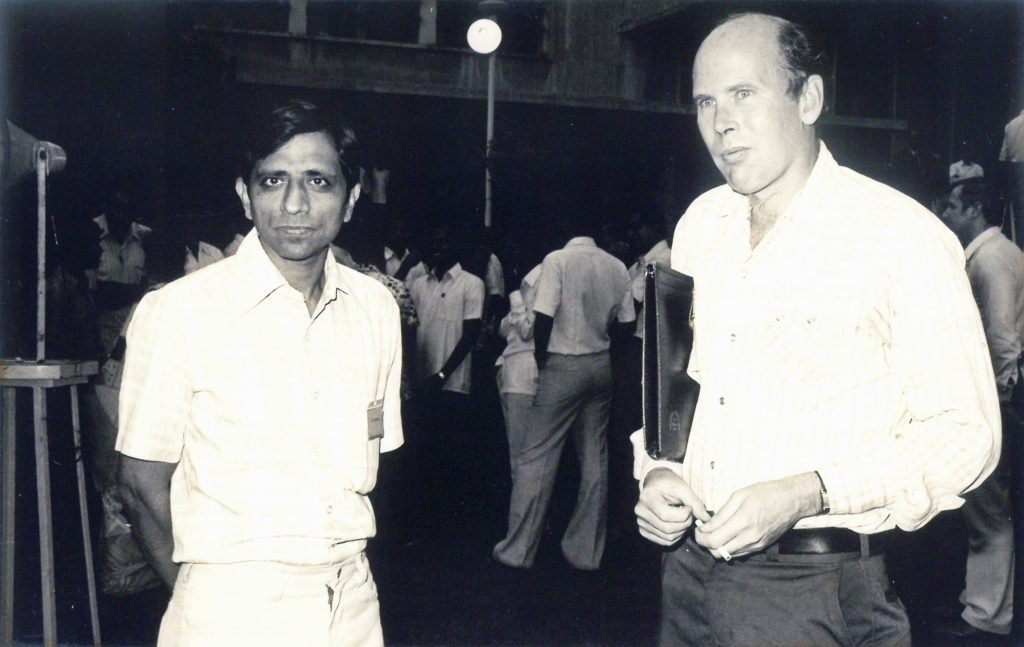
SR: Yes, indeed! After I had joined the Railways, I suggested to my parents that instead of staying in our native village, they might as well come and enjoy living in the hallowed temple town of Srirangam, where I had rented a house. I had also by then lost all hope of doing mathematics research, and my father was egging me on to have a go at the Indian Administrative Service. As I said earlier, my mother diligently read the daily newspapers. One day, when I came back home from work, she surprised me, saying, “You used to be very keen on joining TIFR; today an advertisement regarding admissions has appeared in The Hindu.”
Although I felt diffident about attempting to get in after a long break from mathematics, I nevertheless decided to try. My colleague R.V. Raghavan lent me his notes and books, and I re-studied them all before setting out for the interview. I didn’t even have the money to buy the third-class railway ticket, which cost forty rupees if I remember right, and had to borrow some money for the same. Thankfully, my mother’s sister lived close to TIFR in Bombay and I could stay there.
How did your interview in the TIFR go? Do you remember your interview panel?
SR: The interview panel consisted of K. Chandrasekharan, the Fields Medal winning French mathematician Laurent Schwartz, and one of the then-senior students, Babla Vinayak Singbal. At the end of the interview, I was quite confident that I would be selected, from the way both Schwartz and Chandrasekharan had reacted to my performance.
How did your family receive the news that you were going to give up an assured source of income, albeit meagre, in order to pursue higher studies? Surely, it must have been a very nervous time for your family then.
SR: Pleasantly, the stipend at TIFR was more than the salary in the Railways! Moreover, as I mentioned, I could also stay at my aunt’s for the first year, and was thus able to save enough to even send home a little. My aunt’s family was quite poor, but they were so generous that they did not for a minute make me feel that I was a burden.
Who were your batchmates in TIFR when you joined? Also, how influential were your seniors in your eventual transformation into a world class mathematician?
SR: Among my batchmates were Raghavan Narasimhan and C.P. Ramanujam. Raghavan Narasimhan worked so hard that I felt my effort was inadequate even if I studied ten hours a day! The acquaintance of C.P. was also very enlightening. On the whole, it was a great time.
In what is well documented of those halcyon days, world renowned mathematicians used to visit the TIFR for short durations, and lecture on topics of their interest. Students had to take notes, and many of these notes actually later went on to become coveted sources of mathematical knowledge for the mathematical community. When you were a student there, who came visiting by? And were you a part of any similar note-taking exercises?
SR: In my first year, Francois Bruhat and Bernard Malgrange from France, H.R. Pitt from the UK, and Max Deuring from Germany visited the Institute. I was assigned to write the notes of Bruhat’s lectures. He lectured on locally compact groups and their unitary representations, including the direct integral of their irreducible representations. With my then rudimentary knowledge of mathematics, I wonder even now, how I managed to write it up at all.
As a student, you had TIFR’s founder Homi Bhabha, and the head of the School of Mathematics K. Chandrasekharan, both practically living and operating amidst the larger academic community. Were Bhabha and KC generally accessible to students? Do you recollect any particularly striking set of events from your interactions with them?
SR: There was practically no interaction with Bhabha, except when he met all the freshers, as was his custom. Exactly where the Taj Intercontinental stands now, there was then a restaurant called ‘Rendezvous’, and it was a tradition that the new students treated all the older ones there. In the Institute, it was only a small group at that time, and so we newcomers invited all our seniors in mathematics, including Bhabha and Chandrasekharan. I think we went for tea. Coming as I did from a lower middle class family in Chennai, I didn’t know how to properly handle a fork, knife and spoon. Then some samosas were served. I tried to cut and eat one with a fork, but the peas inside the samosa were simply going all over the place. It so happened that Bhabha was sitting just by my side. He took one quick look at my predicament, and then simply picked up his samosa with his hand, and straightaway bit into it. And it was absolutely crystal clear to me that he was telling me that I simply didn’t have to struggle with those alien forks, and knives. I was so pleased with this! Also, immensely relieved.
We met KC only rarely, although I recall this one incident clearly. KC was giving a course of lectures in my second year, and in the class, I pointed out a lacuna in his argument. After the class was over he sent for me, and I went to his office for the very first time, and as you can imagine, with a lot of trepidation. But he was very genial, and even appreciated my attentiveness. He even discussed with me how to make that particular argument valid. KC looked very hard on the outside, but I had occasion to see that he was soft inside. We students even used to jokingly refer to him as “Sultan” [laughs]. In student circles, you first knew that you’d arrived when KC started saying hello to you. Also, there were two restrooms, and one of them was open to everyone. But the other had its access restricted to only a few privileged users. And when KC gave you the key to that otherwise locked restroom, it meant that you had surely graduated to the next higher level. I also recall the “Order of the Knocking Door”–-a funny phrase coined by students to refer to that rare privilege when KC would say “Ah, you don’t have to go to my secretary. You can just knock on my door and enter.” Then we would exclaim, “Now I have both the ‘Order of the Knocking Door’, and the ‘Order of the Restroom Key’!”
One of KC’s remarkable ideas for bright students joining the School of Mathematics to explore research areas, especially not available anywhere in India at that time, was to depute them to work with leading practitioners outside India. Some of the earliest students at TIFR, like your own PhD advisor M.S. Narasimhan, and C.S. Seshadri as well, were both deputed to France. Were there any similar considerations for you as well? How did your working with M.S. Narasimhan for your PhD come about?
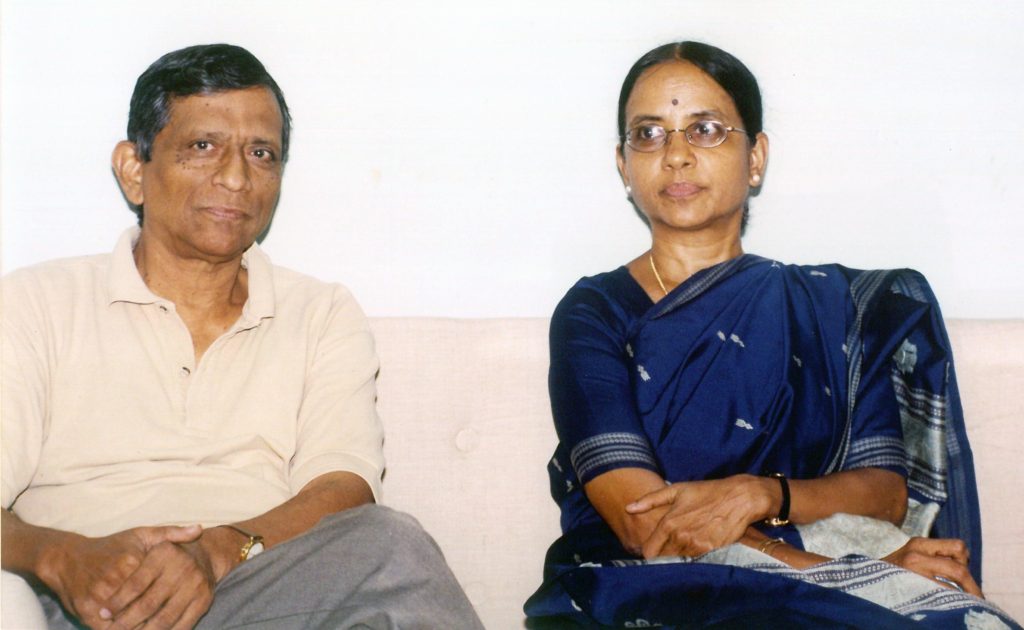
SR: Since I had learnt some representation theory, thanks to Bruhat’s visit, KC suggested that I could go to Columbia University in New York, and work with Harish-Chandra, then a professor there. Sridharan had by then already been deputed to Columbia University, to work with the great topologist Samuel Eilenberg. So I wrote to Sridharan and asked him if it was a good idea, but Sridharan wrote back saying that while Harish-Chandra was a great mathematician, he had had no students at all till then. Since his response was not encouraging, I did not react positively to KC’s suggestion. Later I was interested in algebraic topology, and KC tried to send me on to Frank Adams in Cambridge, but that did not work out.
What problem did you choose to work on, for your PhD?
SR: As I explained above, at that time there was no mentor available in TIFR for most areas of mathematics, and so one did not know how to choose a subject to work on. Sridharan had returned from Columbia and since he was an algebraist, I wrote a couple of papers, one with him and one by myself, in algebra. Later Jean-Louis Koszul came down from France and gave a course on differential geometry, and I wrote the notes of his lectures as well. I loved his approach, and thought I would work on differential geometry for my thesis. Indeed, after my retirement, I wrote up a book in much the same spirit, called Global Calculus, published by the American Mathematical Society.
Barely 24 yet, and still very early into research, a paper of yours was published in 1961 in the venerable American Journal of Mathematics, and spoke about the idea of universal connections. What is the motivation to think about universal connections from the viewpoint of a non-expert reader, but yet one who is still generally interested in mathematics?
SR: Tremendous progress was being made in topology in the late 50’s and early 60’s. Samuel Eilenberg and Saunders MacLane had proved that the usual cohomology theory can be interpreted as associating to any topological space, the space of continuous maps into a particular space (later called an Eilenberg-MacLane space), identifying two continuous maps if they could be continuously deformed into one another. This gave Michael Atiyah the idea of developing a radically new cohomology theory, called K-theory, which essentially replaced the Eilenberg-MacLane space, by another classifying space. The crucial novel input was that every vector bundle is induced by a map into this classifying space. When Koszul in his lectures dealt with the differential geometric notion of connections in vector bundles, I formulated the question whether the universal bundle on the classifying space had a natural connection, which was also universal for all connections in vector bundles. I had no idea how to go about proving such a theorem though. M.S. Narasimhan, who had returned from France at that time, was thrilled by the question, and we worked on it and proved it in a week or two! This was sent to S.S. Chern, one of the great differential geometers of that time, and he gave a very positive feedback. It was therefore no surprise to us when it got accepted by the American Journal of Mathematics, for publication. We later refined this idea further and even generalised it soon thereafter, and that idea too was again published in the same journal.
The idea of vector bundles over algebraic curves has held your attention for a long time, resulting in two of your papers getting published in the Annals of Mathematics. It was also the title of your invited address at the International Congress of Mathematicians (ICM) held in Helsinki in 1978. Deeply related to the pioneering paper of 1965 by Narasimhan and Seshadri on the same theme, what is the primary motivation that attracts mathematicians to this idea?
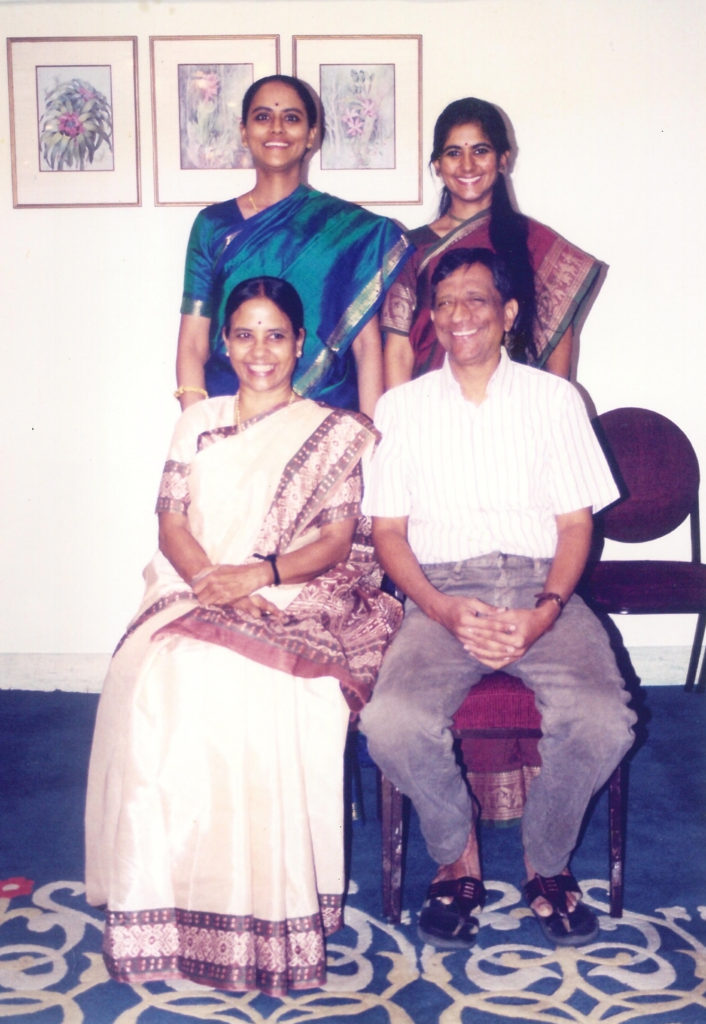
SR: Bernhard Riemann, or perhaps even earlier, C.G.J. Jacobi in the 19th century, had started considering properties of holomorphic and meromorphic functions on spaces other than the complex plane. In particular, they were interested in the zeros and poles of such functions. This study resulted in classifying divisor classes on Riemann surfaces. In the late 1930s, Andre Weil came up with the idea of studying what he called matrix divisors. In a way, this theory remained more or less dormant for about twenty years, till M.S. Narasimhan and C.S. Seshadri began working on it. As they were reviving this theory, David Mumford, who was studying quotients under a group action, came up with the felicitous idea of Stable and Semistable bundles. Narasimhan and Seshadri, in a path-breaking paper, put the two ideas together and proved that unitary representations of the fundamental group and stable (or rather, polystable) bundles are different avatars of the same thing! Once this was established, Narasimhan and I started making explicit these so-called moduli varieties, using ideas from classical projective geometry. It is, even in retrospect, surprising that Felix Klein’s ideas on projective geometry from the nineteenth century became useful again in the 1960s. We derived inspiration from Klein’s paper in Volume 2 of Mathematische Annalen published in 1870! Many geometric ideas in that paper had their counterparts in vector bundle theory.
After your PhD, you spent time with Sir Michael Atiyah at Oxford, and also at the esteemed Institute for Advanced Study, Princeton. These two places are now famous for hosting both ideas and people who have gone on to build beautiful and insightful bridges between the worlds of theoretical physics and pure mathematics. Your own work from the last twenty five years has involved ideas related to the so-called Higgs Bundles, Hitchin Systems and Nonabelian Hodge Theory – all of them which lie at the fertile delta connecting physics to mathematics. For our readers eager to navigate their way around these deep and dense mathematical ideas, can you please provide a bird’s eye view of this exciting mix?

SR: Atiyah was at his most inventive period at that time. Raoul Bott was also visiting Oxford then, and it was great to be there. It is surprising that my work with Narasimhan, both in differential geometry and the theory of vector bundles was found useful by theoretical physicists. I must also say that conversely, the formula found by the physicist Erik Verlinde, was very interesting from the mathematical point of view, but was not accessible to mathematicians till then. It is thus necessary to keep an open mind regarding other areas and to be willing to absorb ideas from them and adapt them. On the other hand, Narasimhan in collaboration with T.R. Ramadas, later solved a problem called gauge-fixing posed by physicists, purely by his mathematical acumen.
Coming to your role as a teacher, you have mentored students who have then gone on to become very successful mathematicians themselves. You were also seriously engaged in the mentoring of Vijay Kumar Patodi when he was a student at TIFR. Could you please recollect your interactions with Patodi?
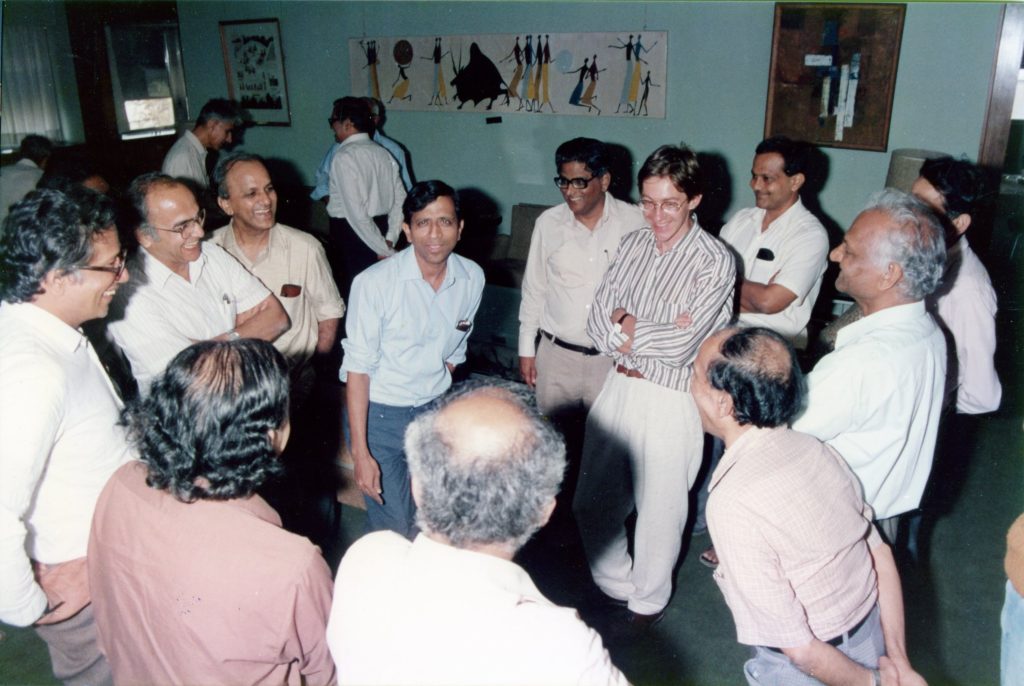
SR: But even more than by my own modest achievements, the fact that my students went on to make a name for themselves is something that gives me great happiness. I like sharing my ideas with others, and my students seem to have liked my style of imparting mathematical ideas. Patodi, who was formally Narasimhan’s student, used to visit me at home, if only to listen to running commentaries of cricket matches late in the night, when matches were still going on in England! I had just then returned from a visit to Harvard University, when he had done something connected with the heat equation, and which also threw light on the work of Atiyah and Singer. But the computations were not elegant, and so the result was not seeing the light of the day. It was thus a Godsend that an elementary idea related to the group of non-zero elements in a field, which I had done to help Robin Hartshorne in his undergraduate lectures, could be modified to simplify Patodi’s computations.
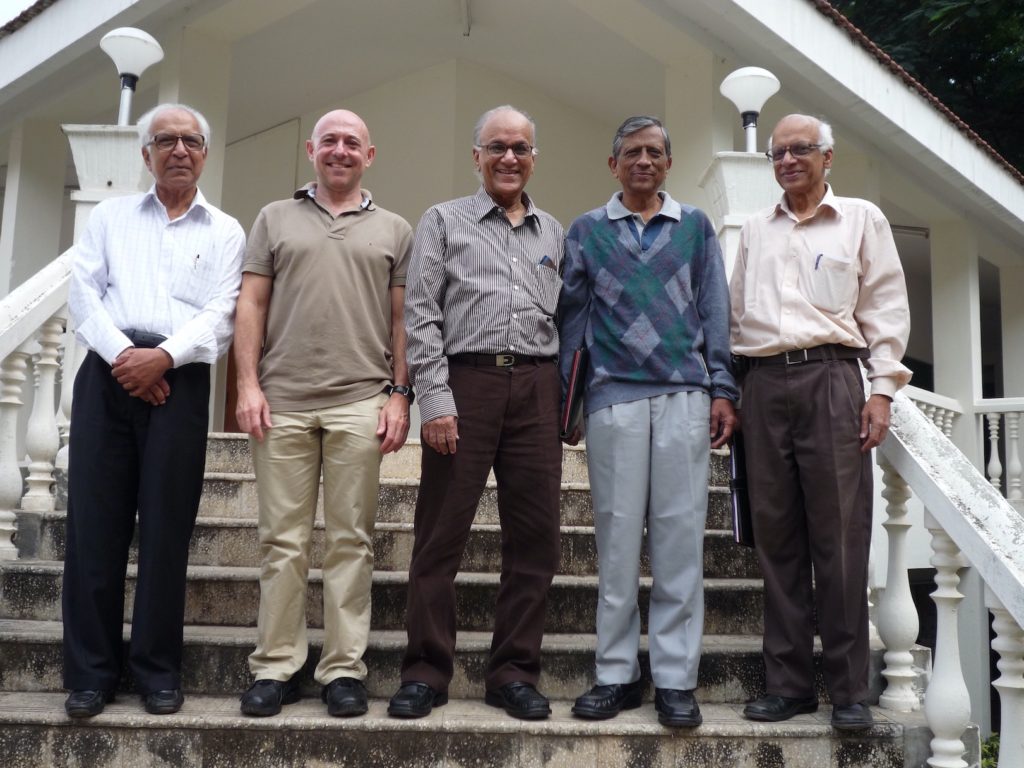
During my visits abroad, I had occasions to collaborate with mathematicians, both young and old. When I visited the Institute for Advanced Study in Princeton, I met a young enthusiastic mathematician by the name of Allan Adler. We began collaborating, and even wrote up a book called Abelian Varieties, published by Springer Verlag.
However, I had the misfortune to see three of my gifted students namely V. K. Patodi, A. Ramanathan and K. Guruprasad, all pass away at a very young age. Usha Bhosle-Desale, Shrawan Kumar, Kapil Paranjape, Mohan Kumar, Indranil Biswas and Jaya Iyer are some of my other students who have done some excellent work.
You mentioned that both Raghavan Narasimhan and C.P. Ramanujam were your own batchmates. While R. Narasimhan had a stellar career in the University of Chicago, the story of the equally successful C.P. Ramanujam was tragically cut short. What led C.P. Ramanujam to take the extreme step? Having witnessed such a shocking event from close, how do you reflect on it?
SR: In my early days at TIFR, it was very pleasant to have discussions with Raghavan Narasimhan, who set high standards for himself and others. I learnt a lot from C.P. Ramanujam’s way of thinking. But his strange behaviour at times was puzzling, since his illness was generally not known, even less understood at that time. He also loved music, and sometimes even appreciated my singing, which of course made me particularly happy. Suddenly, however, he would stop talking for quite a few days, with both Raghavan Narasimhan and myself. His loss at such a young age, was a tragedy difficult to come to terms with.
Which brings us to another aspect of research, which is the need and the ability to find one’s own inner equilibrium. In your own case, did you find solace in the pursuit of music, or was it the love of languages that kept you going, especially when faced with challenging circumstances? Also, since how long have you been actively pursuing music, and under whose tutelage?
SR: As I said earlier, my mother used to sing, and in Madras I listened extensively to Carnatic music on the radio and at concerts. After moving to TIFR, I used to sing in the hostel by imitating musicians whose renderings I had heard in concerts or recordings. I started learning music systematically only when I was nearly 40 from Bombay Ramachandran, who was later awarded the Sangeeta Kalaa Achaarya award by the Madras Music Academy. At TIFR, along with others, I helped run a music association and arranged many concerts, both Carnatic and Hindustani. Sometimes the artists even stayed with us at my home. That is also how I started learning from Chitraveena Ravikiran. Later, whenever I visited Chennai, I continued to take lessons from him.
On an allied note, and given your abiding interest in Sanskrit, have you had a chance to study any of the significant mathematical works of Āryabhaṭa, Brahmagupta or Bhāskara?
SR: No. Although I have read about their works, as well as about mathematicians of comparatively recent vintage, like Raghunatha (who belonged to the Kerala School of Mathematics of the 16th century), I must admit that I was somehow not deeply interested in mathematical history. I may mention here in passing that the revered Puri Sankaracharya has written a book on Vedic Mathematics, and this seer happens to be my mother’s uncle, once-removed! Back to the point, the only things I have learnt of this genre was the work of Pi\dot{\mathrm{n}}gala, and its relation to prosody, thanks to my acquaintance with R. Sridharan, who incidentally has a lot of interest in this aspect.
You have worked most of your life in the TIFR. Is there an aspect of this venerable institution that you would have liked to see function or perform differently, than the way it has so far. If so, what is it that it can do now to reinvent and realign itself strongly, and this time, for the demands of the 21st century?
SR: After retiring from TIFR, I had joint appointments at the Institute of Mathematical Sciences (IMSc) and the Chennai Mathematical Institute (CMI). During the second half of the past century, TIFR in Mumbai, and the Indian Statistical Institute in Calcutta, maintained high standards of research. When I became the dean of the TIFR School of Mathematics, I felt that with our training, we needed to do something besides research, in order to spread the culture and spirit of higher mathematical research in India. I tried to create a teaching institution as part of TIFR, but did not succeed. When I heard that there was an attempt elsewhere to create a Council of Mathematical Research akin to the CSIR, I met the Chairman of the Atomic Energy Commission, and asked him what we could do in this regard. Homi Sethna, who was the chairman then, said that since higher mathematics was under the purview of the Department of Atomic Energy (DAE), we should instead create a National Board for Higher Mathematics (NBHM) under DAE. Accordingly, he appointed me its first secretary, and M.S. Narasimhan became the very first chairman of NBHM. In time, I believe it has become the primary organization in India to support mathematical research, providing various grants, scholarships, etc. This gives me a lot of satisfaction.

Also, there are now many more institutions, like some Indian Institutes of Technology (IITs), additional centres of the Indian Statistical Institute (ISI), Indian Institutes of Science Education and Research (IISERs), Institute of Mathematical Sciences, Chennai Mathematical Institute, where high-level mathematics is taught. The problem of course, is how to retain the highly talented students in India, particularly because going abroad has become reasonably affordable these days. We have to make determined efforts to get bright people to return to India, like Bhabha did in those days.
You have travelled widely as a distinguished academic, and have many collaborators outside India. Could you touch upon your interactions with your peers, and lasting friendships formed in the joint pursuit of mathematics?
SR: I often feel that getting to know intellectuals of a high calibre is one of the side benefits of this profession. I have interacted with André Weil, Raoul Bott, Armand Borel, Michael Atiyah, David Mumford, Masayoshi Nagata, Nigel Hitchin, and many others, all of which I greatly cherish. Later, I had close contact and collaboration with others, such as Arnaud Beauville, Herbert Lange, Oscar García-Prada, Jun-Muk Hwang, Andre Hirschowitz, Masaki Maruyama, Klaus Hulek and others. Certainly, contact with worthy people from other cultures, also widens one’s horizons. Also, it was a pleasure to discuss mathematics with younger mathematicians like Nicole Mestrano, Leticia Brambila-Paz, Anna Peon, Ron Donagi, Steve Bradlow and others.
After I retired from TIFR, I returned to Chennai and worked jointly in both CMI and IMSc. Seshadri knew of my interest in teaching. There were a few doctoral students at IMSc whom I could help, although I was not officially their mentor. I also enjoyed teaching undergraduates at CMI and they seem to have liked my style.
Into your eighties, you continue to push the frontiers, still publishing cutting-edge research. People like you embody the spirit of P. Erdös, I.M. Gelfand, and even our very own recent centenarian C.R. Rao – all of whom upturn conventional dogma that mathematics is a young man’s game. Is age really an overhyped idea?
SR: Thank you, but age does diminish intensity. Thankfully, some of your former collaborators and students keep asking you questions which make you think. I have been lucky that way. Recently, Parimala Raman insisted that I revisit something that I had done some forty years ago over the complex field, and further on to examine its validity over number fields. I am also trying to fill in on some partially worked out ideas that I’ve had in the past. Whether I succeed or not, the attempt itself is satisfying!
On that winning note, Professor Ramanan, we take leave and it has been a real pleasure talking to you. We also wish you robust health, peace and continued research productivity in the coming years. Thank you.
SR: Thanks for your incisive questioning, and also attentiveness to my responses.\blacksquare
